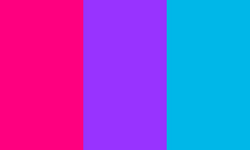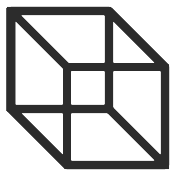Androgyne: Difference between revisions
imported>Sekhet (Added sections for notable people and characters.) |
No edit summary |
||
| Line 10: | Line 10: | ||
[[File:Androgyne Necker Cube.png|thumb|Androgyne symbol. In 1996, self-identified androgyne Raphael Carter proposed taking up this ambiguous geometric shape, the Necker Cube, as a symbol for androgynes, "because it is either concave or convex depending on how you look at it."<ref>Raphael Carter, "Angel's Dictionary." July 14, 1996. [http://web.archive.org/web/19990427014012/www.chaparraltree.com/raq/angels.shtml http://web.archive.org/web/19990427014012/www.chaparraltree.com/raq/angels.shtml]</ref><ref>Nat Titman, "The Necker Cube: Symbol for androgyny." June 25, 2011. ''Practical Androgyny.'' [http://practicalandrogyny.com/2011/06/25/the-necker-cube-symbol-for-androgyny/ http://practicalandrogyny.com/2011/06/25/the-necker-cube-symbol-for-androgyny/]</ref>]] | [[File:Androgyne Necker Cube.png|thumb|Androgyne symbol. In 1996, self-identified androgyne Raphael Carter proposed taking up this ambiguous geometric shape, the Necker Cube, as a symbol for androgynes, "because it is either concave or convex depending on how you look at it."<ref>Raphael Carter, "Angel's Dictionary." July 14, 1996. [http://web.archive.org/web/19990427014012/www.chaparraltree.com/raq/angels.shtml http://web.archive.org/web/19990427014012/www.chaparraltree.com/raq/angels.shtml]</ref><ref>Nat Titman, "The Necker Cube: Symbol for androgyny." June 25, 2011. ''Practical Androgyny.'' [http://practicalandrogyny.com/2011/06/25/the-necker-cube-symbol-for-androgyny/ http://practicalandrogyny.com/2011/06/25/the-necker-cube-symbol-for-androgyny/]</ref>]] | ||
[[File:Gender-Symbol Hermaphrodite Androgyne dark transparent Background.png|thumb|A mix of the male (Mars) and female (Venus) [[gender symbols]]. A symbol for androgyne, hermaphrodite, or [[intersex]]. Sometimes shown pointing in any different direction. Also the alchemist symbol for iron sulfate. Unicode: U+26A8 ⚨]] | [[File:Gender-Symbol Hermaphrodite Androgyne dark transparent Background.png|thumb|A mix of the male (Mars) and female (Venus) [[gender symbols]]. A symbol for androgyne, hermaphrodite, or [[intersex]]. Sometimes shown pointing in any different direction. Also the alchemist symbol for iron sulfate. Unicode: U+26A8 ⚨]] | ||
'''Androgyne''' (Latin from Greek, '' | '''Androgyne''' (Latin from Greek, ''andras-'' "man" + ''gune'' "woman", pronounced AN-druh-jin, IPA: ˈan-dɹə-ˌdʒīn),<ref>[http://www.merriam-webster.com/dictionary/androgyne http://www.merriam-webster.com/dictionary/androgyne]</ref> '''androgyn''' or '''androgynous gender''', is an identity under the [[nonbinary]] and [[transgender]] umbrellas. Some writers use androgyne as an umbrella for many nonbinary genders.<ref>''Androgyne Online.'' [http://androgyne.0catch.com/ http://androgyne.0catch.com/]</ref> Androgynes have a [[gender identity]] that can be a blend of both or neither of the [[binary gender]]s. They may describe this as being between [[female]] and [[male]], between man and woman, between masculine and feminine or simply 'in between.' They can also identify as neither feminine or masculine, or neither female and male. | ||
==History== | ==History== | ||
Revision as of 13:33, 7 April 2020
See also: Androgyny
 Meaning The red symbolises woman and the blue symbolises man, and they are separated by purple (a mix of them both), yellow (representing non binary-ness) and grey (representing neutrality) | |
| Related identities | androgyny, bigender |
|---|---|
| Click here to see alternative flags! | |

Androgyne (Latin from Greek, andras- "man" + gune "woman", pronounced AN-druh-jin, IPA: ˈan-dɹə-ˌdʒīn),[3] androgyn or androgynous gender, is an identity under the nonbinary and transgender umbrellas. Some writers use androgyne as an umbrella for many nonbinary genders.[4] Androgynes have a gender identity that can be a blend of both or neither of the binary genders. They may describe this as being between female and male, between man and woman, between masculine and feminine or simply 'in between.' They can also identify as neither feminine or masculine, or neither female and male.
History
Historically, there have been some instances of people using the term bisexual to refer to androgynes, androgynous people, or hermaphroditic beings. An example of the use of this word, found in pop culture, is in the 50th episode of the 2nd season of Star Trek, "The Trouble with Tribbles", where Dr. McCoy refers to the tribbles (an alien species) as bisexual.[5]
In 2014, when Facebook made 56 genders available for its users, two of these were androgyne and androgynous.[6]
Androgynes and androgyny
Some people who call themselves androgynes identify with androgyny as a gender presentation, or have or wish to obtain an androgynous, 'in between', or neutral body, others see this as only a matter of gender identity and may express their androgynous gender through their personality or activities such as crossdressing.
Some use the word androgyne to mean only a gender identity, and use the words androgynous or androgyny for gender expression.[7] An androgyne may or may not look androgynous. Someone who looks androgynous may or may not be an androgyne. A "psychological androgyne" is one term for a person who has an androgynous gender identity, but doesn't necessarily look androgynous,[8] and some such people have created the word "androgyneity" for their inner androgyny, to distinguish it from outward androgyny of appearance.[9] These terms are useful for people who feel they are androgynes, but aren't sure if they can call themselves so, because of how they look. The connection between androgyny and androgynes can cause frustration for some people:
"Those born with androgynous looks -- especially if they are not androgynes -- often wish that their gender presentation was unambiguous so as to not be teased, harassed or mistaken for the opposite sex, while androgynes born without androgynous looks (i.e. psychological androgynes) often wish that their gender presentation was markedly ambiguous so as to convey outwardly what they feel inwardly."[10]
Androgynes who don't look androgynous may wish they looked more androgynous, while non-androgynes who look androgynous may wish they looked less androgynous.
On the other hand, some androgynously presenting people only use 'androgyne' for their presentation, while having a different gender identity. For example 'genderqueer androgyne' or 'agender androgyne', similar to how one may say 'genderqueer woman'. There are also people who describe themselves as a "masculine androgyne" (on the female-to-male or trans masculine spectrum) or a "feminine androgyne" (on the male-to-female or trans feminine spectrum) meaning that they almost but not quite fit into that part of the gender binary.[11]
Some androgynes don't think of themselves as transgender or transsexual (cisgender). Some transgender or transsexual androgynes go on a physical transition to make their body more androgynous.[12]
Androgynes and intersex
Historically, an androgyne has been a word for an intersex person, and this use of that word is not obsolete. The sex of a person's body is different than their gender identity. Intersex is a physical sex, and androgyne can mean either that, or a gender identity. One concern about using the word "androgyne" for one's gender identity is that it can be mistaken for saying that one is intersex.[13]
That said, there is a relationship between a person's sex and gender, and the connection between intersex and androgyne might not end there:
"Androgyneity [sic, meaning androgyny of gender identity, rather than of gender expression], when conceptualized as intergender, can be seen as the psychological counterpart to intersex. Androgynes are intermediate in gender, while intersex(ed) folks are sexually intermediate. [...] some intersex activists opine that androgynes have intersex brains (and that transsexuals are intersex on account of the relationship between their brains and their genitalia)."[14]
There may be a connection between intersex conditions and not only androgyne gender identities, but transgender identities of many kinds. This is not known for certain at this time.
Similar genders
The etymology of the word "androgyne" describes a mix of male and female, although it is just as often used to mean an absence of male or female traits. A person who feels they are neither female nor male might find a different word suits them better, such as neutrois, aporagender, or maverique. A person who feels they are neither female nor male, and are completely genderless, might find that agender is a word that fits them better. There is another concern about the etymology of the word. Some people with nonbinary gender identities who could call themselves androgynes prefer not to, giving the concern that the word "androgyne reinforces the gender binary by invoking the two polar [binary] genders in its very name. Some genderqueer and gender variant folk say that there are as many genders as there are stars in the sky."[15] For this reason, androgyne isn't as good of an umbrella term as "nonbinary." That said, anyone who wishes to call themself an androgyne has the right to do so.
Like androgyne, intergender is a gender identity that is in the middle between the binary genders of female and male, and may be a mix of both. Intergender people may or may not give an androgynous gender expression. One difference is that some intergender people argue that it is an identity label that only intersex people should take up.
If "androgyne" is thought of as two genders, or a mix of genders, then it might be under the multigender umbrella, for gender identities that are made of several genders. This depends on one's definition of androgyne. One very similar multigender identity is bigender, which is a gender identity made of two genders, or a mix of both. The difference is that for a given bigender person, those two genders may be female and male, or they might be two other genders. (For example, female and a nonbinary gender.) Another difference is that bigender is more widely agreed to be only a gender identity, not a gender expression.
Androgyne and genderqueer are sometimes used interchangeably, but the nuances of genderqueer include intentional political subversion and rebellion. Genderqueer also gives no specific idea about whether a given genderqueer person feels like both female and male, neither, or any particular connection to those gender identities.
Notable androgynes
See main article: Notable nonbinary people
There are many more notable people who have a gender identity outside of the binary. The following are only some of those notable people who specifically use the word "androgyne" for themselves.
- Jennie June (b. 1874) was a Victorian and Edwardian era writer and activist for the rights of people who didn't conform to gender and sexual norms. She published her first autobiography, The Autobiography of an Androgyne in 1918. Her goal in writing her books were to help create an accepting environment for young adults who don't conform to gender and sexual norms, because that was what she would have wanted for herself, and she wanted to prevent youth from committing suicide.[16] June formed the Cercle Hermaphroditos in 1895, along with other androgynes who frequented Paresis Hall in New York City. The organization was formed in the hopes "to unite for defense against the world's bitter persecution," and to show that it was natural to be gender and sex variant.[17]
Please help expand this section.
Androgyne characters in fiction
See main article: Nonbinary gender in fiction
There are many more nonbinary characters in fiction who have a gender identity outside of the binary. The following are only some of those characters who are specifically called by the words "androgyne," either in their canon, or by their creators.
- Snailed It by SnaiLords, who "identifies with both genders" and described themselves as an "androgynous snail".
Please help expand this section.
See also
External links
- Gender Wiki's Androgyne article
- Androgyne Online
- Androgyny RAQ (Archive of a 1990s website)
- Practical Androgyny
- Bibliography of Books Concerning Androgynes and Androgyny
References
- ↑ Raphael Carter, "Angel's Dictionary." July 14, 1996. http://web.archive.org/web/19990427014012/www.chaparraltree.com/raq/angels.shtml
- ↑ Nat Titman, "The Necker Cube: Symbol for androgyny." June 25, 2011. Practical Androgyny. http://practicalandrogyny.com/2011/06/25/the-necker-cube-symbol-for-androgyny/
- ↑ http://www.merriam-webster.com/dictionary/androgyne
- ↑ Androgyne Online. http://androgyne.0catch.com/
- ↑ The Star Trek Transcripts: The Trouble with Tribbles: [...] it seems they're bisexual, reproducing at will. [...]
- ↑ Eve Shapiro, Gender circuits: Bodies and identities in a technological age. Unpaged.
- ↑ Androgyne Online. http://androgyne.0catch.com/
- ↑ Androgyne Online. http://androgyne.0catch.com/
- ↑ Stephe, "Psychological androgynes." Androgyne Online. 2013. http://androgyne.0catch.com/psych.htm
- ↑ Androgyne Online. http://androgyne.0catch.com/
- ↑ Raven Kaldera, "Feminist On Testosterone: The View From An Intersexual FTM." February 2003. http://www.ravenkaldera.org/gender-archive/feminist-on-testosterone.html
- ↑ Androgyne Online. http://androgyne.0catch.com/
- ↑ Raphael Carter, "Not this, not that: A meditation on labels." July 14, 1996. Androgyny RAQ (Rarely Asked Questions) (personal site). https://web.archive.org/web/20041209234238/http://www.chaparraltree.com/raq/notthis.shtml
- ↑ Androgyne Online. http://androgyne.0catch.com/
- ↑ "Androgyne Online." http://androgyne.0catch.com/
- ↑ Meyerowitz, J. "Thinking Sex With An Androgyne". GLQ: A Journal of Lesbian and Gay Studies 17.1 (2010): 97–105. Web. Retrieved April 13, 2017.
- ↑ Katz, Jonathan Ned. "Transgender Memoir of 1921 Found". Humanities and Social Sciences Online. N.p., 10 October 2010. Web. Retrieved April 13, 2017.

